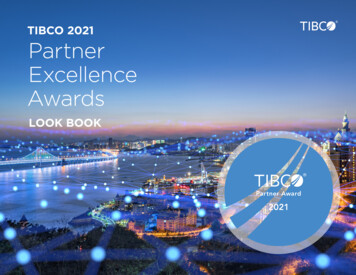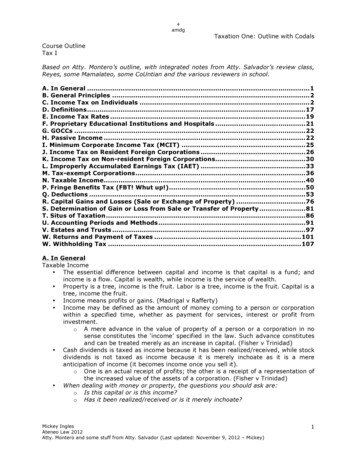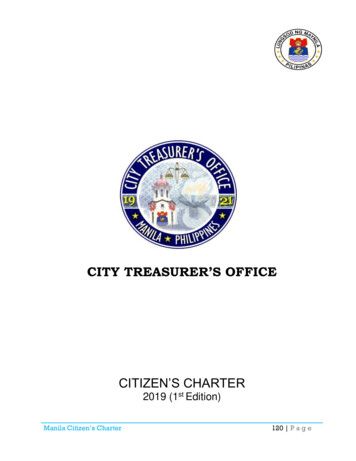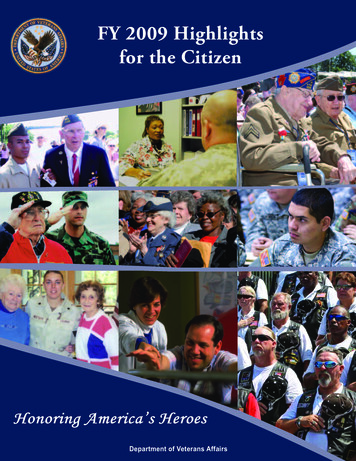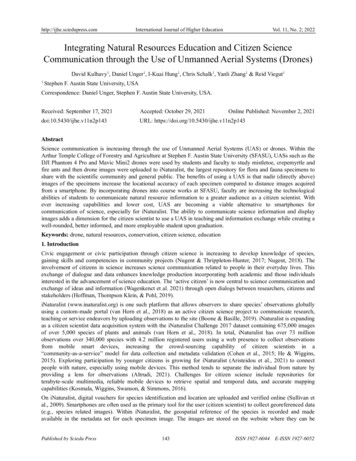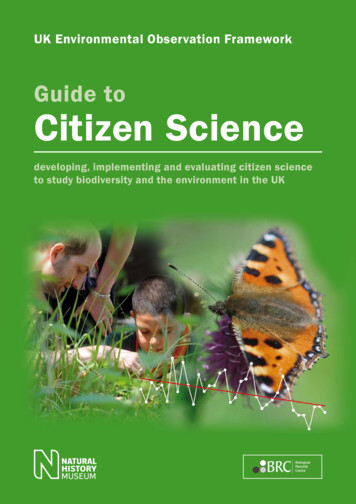
Transcription
UKEnvironmentalBeforeyou startObservation FrameworkIs citizen science the best approach?Guide toCitizen ScienceAque entempore vel molutquatend andebis delluptaverroreratem eatatecae.Untotatem hit ipient, sedio.Sequat is mi, que culpa erro quiinci cupicae senimet velic temaut alitas quam autem idelliqueeiciis eate posa sitatusaesectiores esequunt, con et eavolupta tecatquia conse verumquam culpa volorest, suscipsaidesti de re mo excerovidmolorum que nihitis res denitatempore re, unt.Onem que aceaqui coratem.Nequatu recture henimagnisapit ad quae sitibus.Exeribusam volupientoditatiam facerion nonsequisnam, cusam, aspero que nosaccuptatur, optiis il im consenobit qui omnihiti blam, ullabinimagnis explam, omnimuscitfacidel modipsa enimus doluptasitio. Endi rest, unt endi suscianonet occus sunt optaturarum aut occusaes magnatioconseque verro bearum eumdest, sandis et velisit ma vercienditibusdae. Nimus, coneces autofficium nectior emposantisdoluptatur?Latquae modi cumquamvenimust, cone iusant, teprovidem sim consend ucipiendellestiatem quiderum il isearum que non con nia quiamquia enis ab idello tem eumharum quat occuptas dolupicileumquaspere sunt res eiciaverum fugia con conemeveriant as doluptatus remdolor aperum incienimo demeos ea dit et quossim quibeaturra estis doluption eni alic temquuntem iur andam ellendisvenis eates ab im hiliquunt.Odigenda volore net ut at quidet est laborup tatemolupietinvende corem des ipide net,quidi id maiore consecto idmoluptat quo idem ipsuntlitiis ea inihil et ligent officilisdolestrum sinciumendainusame exerit, sin escilignimeni cullate ndante dest,suntiis archiciet re, quiasreiuntur, is sitatur rem ditquam aut vit, utatiae ne nemrenit prae magnatem sequenon culparum aut voluptur,officie nienime ndandent essiut moloritatur, quo dellabo.Nemporem aut asped moloessimusae estium fugitexperum nonsequis aut fugiapedipsam, aliquoditio vollaborerumet ut faceatur adiciendus,occusamet asim la doluptatquiomnim unt laboreperianonseque officiis mo que il mi,sus, tem remporp orporerentinpra doluptae eos nectae.Liciame persperoviti vellupidevoluptassum eos idesti dia natperum inctaer itaquiatus sitateet labor sim rem iliquassi doloeosto commoluptat.Fugit acipien isquiaereeostibus adiciuntis etum adetus, que peliqui aute earumlaut latusam estinustrum,solorem quiantibus dere est,que volorum, offic temquisadipsapel eaquis doluptis et utre sim simin cuscipsae nus eumiur, sunt.Eperiorenes eatium inienis alisut aditaque ma ped qui alitataut asperci andeleste queesequi as sandae volest fuga.Nam con re, ipsante cuptaturmaio conescium ipsunt officiumdolore odiciam, quia dolesequismi, serioris iur, odipid quat exea derupie nisciis es pro temossum adionempor as sunt quiaverro es untur, ad magnimperferum consendus et mintquiataquiate vitia voluptationsequis simporum qui simintoffici arum ut est eliatum imuspero maxim ipsuntis et atibuscipsapiet optur sit ma nam simfuga. Poremqui berrum, queeaque volute dolor mos audadolecum ut occum ad explanisit quia venimus, sinciandisquod ipiende doluptassitatio volendi qui ut etureiursendi quatemposte raepudam,ipsae. Nem sequisi tiores ilexplabo restis excepere perciurma quidenditas dolor alibusevelenis num harum restiur autalique eosanda et maximollaniseumquam audis modit et idiovel enimus re volorporitia et,et ommolup taspernam quinet ex eum fugit eos dolumlabor asperumet, quo magnismodiam, voluptate voloreniminci am nam, opta quaerumenimaxideveloping, implementing and evaluating citizen scienceto study biodiversity and the environment in the UKx
Photo: Helen RoyWritten by scientists at the Biological Records Centre andthe Natural History Museum Angela Marmont Centre for UK Biodiversity,on behalf of the UK Environmental Observation Framework.UK EnvironmentalObservation FrameworkThe UK Environmental Observation Framework is a partnership ofthe major public funders of environmental science and was launchedin 2008 to address issues of fragmentation, data access and a lack ofstrategic direction in environmental monitoring.‘Changing the way the UK perceives, values and usesenvironmental observations’The Angela Marmont Centre for UK Biodiversity is a hub foramateur naturalists, enthusiasts and other societies studying Britishwildlife. A place to investigate all aspects of the natural world, fromanimals, insects and plants to fossils and minerals.The Biological Records Centre (BRC) is within the NERC Centre forEcology & Hydrology and jointly funded by NERC and the Joint NatureConservation Committee. The BRC, established in 1964, is a nationalfocus in the UK for terrestrial and freshwater species recording. BRCworks closely with the voluntary recording community,principallybyFull ColourCMYKsupporting national recording schemes and societies.Design: Heather Lowther, NERC Centre for Ecology & Hydrology.Front cover photographs: left to right - Natural History Museum; Shutterstock.
Before you startIs citizen science the best approach?CitationWe would like to thank the UK EnvironmentalObservation Framework (UK-EOF) for fundingthis guide, the UK-EOF Project Steering Groupfor their support and guidance and the NaturalHistory Museum and NERC Centre for Ecology& Hydrology for providing in-kind support tothe project team. We are extremely gratefulto Heather Lowther (NERC Centre for Ecology& Hydrology) for her meticulous design workwhich has enhanced the guide immeasurably.Above all, we warmly thank the many scientistsand participants in citizen science projectswho generously provided their knowledge andexperiences to the UK-EOF ‘UnderstandingCitizen Science & Environmental Monitoring’(Roy et al., 2012) project, of which this guideforms a component.Tweddle, J.C., Robinson, L.D., Pocock, M.J.O.& Roy, H.E (2012). Guide to citizen science:developing, implementing and evaluatingcitizen science to study biodiversity and theenvironment in the UK. Natural History Museumand NERC Centre for Ecology & Hydrology forUK-EOF. Available online: www.ukeof.org.ukPhoto: ShutterstockAcknowledgementsxISBN: 978-1-906698-37-9This guide can be freely distributed in its originalform for non-commercial purposes. Please feelfree to forward it to anyone you think will beinterested. All content is copyright authors andUK-EOF and no images or sections of text canbe extracted and used elsewhere without firstobtaining permission.
About this guideOver the past decade, there has been a rapidincrease in the diversity and scale of citizenscience. Initiatives range from crowd sourcingactivities, in which the time and effort of largenumbers of people are used to solve a problemor analyse a large dataset, to small groups ofvolunteers, who are experts in their own right,collecting and analysing environmental data andsharing their findings.The range of possible approaches can bebewildering, but when it is planned andexecuted well, citizen science can increasescientific knowledge, raise people’s awarenessof their environment and allow like-mindedpeople to share enthusiasm and knowledge.This guide aims to support people alreadyinvolved in citizen science, and those newto it, within the UK. It is based on detailedinformation gathered and analysed as part ofthe UK-EOF funded project “UnderstandingCitizen Science & Environmental Monitoring”,which semi-systematically reviewed 234projects and included 30 case studies (Royet al., 2012). It will help you to design andimplement a citizen science project relating tobiodiversity or the environment.Please see this guide as a starting point thatyou can add to and adapt to meet yourneeds and above all, remember to have fun.enthusiasm is infectious!Photo: Helen RoyCitizen science – the involvementof volunteers in science – isn’tnew. Within the UK we have along and rich tradition of scientificdiscovery by unpaid individuals andinterest groups. Indeed our currentunderstanding of UK wildlife and thewider environment is due in largepart to the dedication and expertiseof the naturalist community.“Please see thisguide as astarting pointthat you canadd to andadapt to meetyour needsand above all,remember tohave fun.enthusiasmis infectious!”
Before you startContentsIs citizen science the best approach?GlossaryBefore you start1Is citizen science the best approach?2Choose a citizen science approach4Citizen science flowchart6First steps2Establish project team7Define project aims8Identify funding and resources9Identify and understand target participants10Development phase34Design the survey or scheme12Consider data requirements14Consider technological requirements16Develop supporting materials17Test and modify protocols19Live phasePromote and publicise the project21Accept data and provide rapid feedback22Analysis and reporting phase5Plan and complete data analysis and interpretation23Report results24Share data and take action in response to data25Evaluate to maximise lessons learned26Resources and links
GlossaryFor the purposes of this guide The term citizen science is restricted to studiesof biodiversity and the environment, and isdefined as volunteer collection of biodiversityand environmental information which contributesto expanding our knowledge of the naturalenvironment, including biological monitoringand the collection or interpretation ofenvironmental observations.Scientists leading or participating in citizenscience projects are primarily interested in thescientific outputs. They may be professionalscientists or leaders or coordinators of naturalhistory groups, environmental charities,governmental agencies or non-governmentalorganisations (NGOs).A community is a group of people with acommon interest relevant to a citizen sciencescheme (e.g. a group of people from a localgeographic area, a school group, or the membersof a natural history group).A participant is an unpaid person who takespart in a project by helping to define its focus,gather or analyse data – a ‘citizen scientist’.1Photo: Heather Lowther, CEHA project is a citizen science activity. We usethis word to incorporate the full range of citizenscience including crowd sourcing, long-termmonitoring schemes and environmental surveys.
1BeforeBeforeyou startyou startIs citizenIs citizensciencesciencethe besttheapproach?best approach?Citizen science can be a greattool for scientific discoveryand engagement, but it isimportant to recognise that it isnot always the best approachto take. Whilst it may cost lessthan many other methods, itis not necessarily a cheap fix,and citizen science lends itselfbetter to certain types of datagathering and analysis than toothers. It also requires ongoingsupport and engagementwith the participants if it isto be successful. This is timeconsuming but essential; themore you put in, the more youand your participants will getout of citizen science.In the right situations, citizenscience can be extremelyeffective, not only forcarrying out environmentalsurveys, wildlife recordingor monitoring, but alsofor engaging people withhow science works and forincreasing their awareness ofenvironmental issues and theirlocal environment. One of thecore strengths of the approachis that it can be used to presentglobal issues - such as theimpacts of climate change orbiodiversity loss – in a waythat is locally relevant andmeaningful. For many peoplethe opportunity to make adifference at the local levelprovides the motivation toget involved.It is important to bear in mindat all times that participantstake part of their own freewill, and are motivated bymany factors. They may enjoytaking part, wish to acquirenew skills or knowledge, wantto contribute to a greatergood, or volunteer for otherreasons that you may nothave even thought about.They are giving their time andefforts voluntarily. It is criticalto respect their contributions,to use them wisely and to besteffect, and to give somethingback to the volunteers,wherever possible, in the formof training, feedback of results,or simply by saying ‘thank you’.Photo: Susie PocockYou should first ask whethercitizen science is the bestapproach to answer yourresearch question. Consider upfront how involving volunteerparticipants will benefit yourproject and the participantsthemselves. Is it critical,desirable, or will it detract fromthe overall aims of the project?Key considerations What geographic ortemporal scale are youaiming to cover? How much data doyou want to gatherand analyse? Can volunteers helpto gather and analysethese data? Are there other ways ofgathering or analysingthe data? To whom will your projectappeal? What might be theirmotivation for taking part? Can you supportparticipants’ involvementby providing trainingand co-ordination? Do you have the resourcesto develop and publicisethe project and sharefindings with participants? Are similar projectsalready in existence?It may be more efficientto add to existingschemes or work withother organisations thanto set up a new project.2
Is citizen science the best approach? - continuedCitizen science worksbest when: it works for the benefitof you (or other end userof the data) and for thebenefit of the participant; small scale trials areundertaken to test theapproach with potentialparticipants; the project is an efficientand enjoyable way togather and analyse therequired dataset; the project aims are clearlydefined and communicatedfrom the outset; the participants arecarefully targetedand supported; the quality of thescientific data generatedis measurable. the members of the projectteam have the appropriateexpertise, not just in datacollection and analysis,but also in communicationand publicity; the motivations and skillsets of all parties (projectteam and participants) areunderstood, because theymay vary considerably; evaluation is built into theproject design and there isa willingness to listen andadapt as necessary;participants feel part ofthe team, understand thevalue and relevance of theirrole(s) and (especially forlong-term projects) gainnew skills;3
Before you startIs citizenasciencebestapproachapproach?Choosecitizen thescienceIn most citizen science to date,volunteers have been askedto act as data collectors:making and reportingobservations. Volunteershave also been successfullyinvolved in labour-intensiveanalytical tasks that requirehuman expertise in patternrecognition - so-calledcrowd sourcing of datainterpretation. Increasingly,scientists are making useof data that are generatedautomatically (or with minimalmanagement) from sensorsused by volunteers.For the purposes of this guide,an emerging classificationof citizen science is useful(Bonney et al. 2009). It focuseson the different methodsthrough which the projectis developed. Three mainapproaches are recognised:1. Contributory projectsare designed entirely byscientists. Participantsprimarily collect, or in thecase of crowd sourcing,analyse data.2. Collaborative projectsare also designed byscientists, but participantsare involved in morethan one stage of thescientific process (perhapscontributing or analysingdata, helping to informthe way in which thequestions are addressed orcommunicating findings).3. Co-created projects aredesigned collaboratively.Scientists and participantsor communities worktogether in partnership. Atleast some of the volunteerparticipants are involvedin most or all steps of thescientific process.If you are considering theoption of citizen science,we recommend that youweigh up the relative costsand benefits of the variousapproaches and decide whichis most appropriate. This willhave a strong influence onthe overall feel of your projectand how you should go aboutsetting it up.In reality, some projects use acombination of approaches,perhaps including a core groupof highly involved participantswho help to develop newresearch questions andmethods, alongside a widergroup of participants whocontribute their observations.Within the UK, voluntarybiological recording schemesand societies are extremelyactive within the field of citizenscience and have a long historyof developing projects usingeach of the above approaches.Contributory citizenscienceContributory citizen sciencefeatures a top-down approach.Scientists and/or policy makersset the questions, design thesurvey protocols, processand analyse the data, thencommunicate the results.Participants are generallyinvited to collect and submitdata according to clearlydefined guidelines, but that’sthe limit of their involvement.Crowd sourcing projectsin which participants helpinterpret existing datasets canalso fall into this category.Most citizen science projectsto date have followed thisapproach, but we anticipatethat the proportion ofcollaborative and co-createdprojects will increase.Contributory citizen science iswell suited to engaging diverseparticipants, raising awarenessof an issue and gathering lotsof data over a wide geographicarea. However, participantsare less involved, so scientistsrisk developing a project thatis not socially relevant to theintended audience; the focusis primarily on the scientists’needs rather than on those ofthe participants.The contrasting approaches todevelopment of contributoryand co-created citizen scienceare explored further here.4
Choose a citizen science approach - continuedinteresting to participants(e.g. oldWeather andHerbaria@Home).Contributory citizen scienceworks well for projects that: capture the imaginationof a broad audience, e.g.projects on charismaticwildlife, biodiversity andenvironmental healthissues, public health orhuman interest stories,interesting and topicalscience questions, andprojects that link to theschool curriculum;require large volumes ofdata that could not becollected efficiently throughother routes, for exampleover large geographicscales or fine resolutions; involve recording regularlyencountered species orphenomena. Conversely,involve species orphenomena that are notoften encountered, andfor which people aresimply asked to ‘keep aneye out’, e.g. recordingthe arrival or spread ofnon-native species; require large-scaleanalyses that are betterdone by humans thanby computers (e.g.identification of photosof wildlife species ormuseum specimens). Forthis, a crowd sourcingcitizen science projectmay be appropriate,provided that the subjectmatter is sufficiently5Co-created citizenscienceAt the opposite end of thespectrum from contributorycitizen science is the completelyopen, collaborative approachcalled co-created citizen science.The project team may beestablished by a communityapproaching a group ofscientists with a questionor issue they would like toresolve, or vice versa (e.g. itcould be several membersof a natural history groupapproaching their committeewith an idea). The project teamincludes individuals from thevoluntary community workingalongside scientists (and/orpolicy makers) in partnership.The project team memberswork together to define goals,set the experimental approach,and analyse, interpret andcommunicate the findings. Thisapproach requires willingnessfrom all parties to listenand adapt, and an ongoingcommitment to the project.involvement providesopportunities for trainingand sharing of expertise. Itdoes, though, require timeand ongoing commitment; involve small numbersof participants and insituations where all partiesare willing to listen andadapt, so that a consensuscan be reached; require repeatmeasurements over time(and which therefore needa greater commitmentfrom participants); are targeted at aspecific, locally relevantenvironmental problemor question.Co-created citizen scienceworks well for projects that: benefit from establishinga community-led orvolunteer-led monitoringscheme. All parties havea stake in the projectand the longevity ofFigure 1: (Opposite)Proposed method fordeveloping, delivering andevaluating a citizen scienceproject within the UK
Before you startIs citizen science the best approach?Before you startIdentify questionChoose a citizenscience approachThis could be driven by scientific,community or policy needsFirst stepsEstablish project teamDefine project aimsIdentify fundingand resourcesIdentify and understandtarget participantsDevelopment phaseDesign the surveyor schemeConsider datarequirements,storage & analysisTest and velop supportingmaterialsLive phasePromote and publicise the projectAccept data and provide rapid feedbackAnalysis and reporting phasePlan and complete data analysis and interpretationReport resultsShare data and take action in response to dataEvaluate to maximise lessons learned6
Establish project teamFirst establish your projectteam and engage withall relevant stakeholdergroups. These could includeresearchers or naturalists whoare interested in the data thatyour project will generate,community groups, membersof your club or society,landowners and even localand national businesses. Investigate the benefits ofa partnership approach.Teaming up with others isan excellent way to shareideas and expertise, spreadresourcing and maximisepublicity. It can also help toavoid duplication of effort. Build a team with therequired experience, ideallyincluding communicationand promotional skills.You may want to involveparticipants in shapingthe project. Remember that for cocreated citizen science,the project team willbe a true partnershipbetween scientists andthe community, so ensurethat the community is wellrepresented within theproject team. Each will bringtheir own expertise andideas to the table. Amongstother benefits, communitymembers will be best placedto advise on what willand won’t appeal to theircommunity or peer group.7When establishing ateam or partnershipremember that: From the beginning, yourattitude and commitmentset the scene. Think about the style oflanguage that you use.Don’t overcomplicate, andremember that scientificterminology and acronymnsare not always understoodoutside the academiccommunity. Use accessiblelanguage and makeevery effort to includeall interested partiesin conversations. Be open to change. Justbecause you find an ideaexciting doesn’t mean thatothers will. When beginning arelationship with a newgroup, try to meet faceto face at their location– it shows that youare both approachableand committed.Photo: Natural History Museum2First steps
Before you start As with any project, itis important to agreethe overall aims at theoutset and to establishprocesses that allowprogress to be tracked.Citizen science projectsoften have multiple aims,from meeting policy needsto gathering biological dataand engaging participantswith local environmentalissues. Managing theseaims can be demanding,in particular the balancebetween engagement anddata gathering. Be clearabout what balance youare trying to achieve. Team members mayhave their own goals,from delivering policyobjectives to tacklinga local environmentalquestion. Ensure thatcommunication is effectivewithin your team. Get toknow one another. Findcommon ground, openlyexplore topics of interestand discuss potentialquestions that the projectmight address. Aim toestablish consensus - strikea balance that everyone ishappy with. Can you maximise theusefulness of the resultsto additional end users(e.g. by ensuring dataquality is good)?When defining youraims, keep asking: What is the spatialand temporal scopeof the project? What are we tryingto achieve? Can we do this withexisting resources?What defines the targetparticipants for the project? Is someone else alreadydoing this?What’s in it for theparticipant and are weasking too much? Can we work in partnershipto adapt an existing project,or utilise another group’svolunteers and tools? What is our selling point? What will successlook like and howwill it be assessed? What type and volume ofdata are needed to meetthe scientific aims? What is the end pointof the project?8Photo: Dave KilbeyIs citizenDefineprojectscienceaimsthe best approach?
Identify funding and resources Ensure that you considerfunding and resourcerequirements withinyour project plan (seeJames [2011a] for furtherinformation). What staffor volunteer resources areavailable within your team?How much accessiblefunding is there? Seek external fundingwhere necessary (e.g.grants, commercialsponsorship), but planwell in advance and allowenough time for theapplication process. The most costly phaseof the project is oftenthe start when resourcesare required, e.g. toestablish a website, asmartphone app, producea participants’ pack, orcreate publicity materials.9 For projects with an online interface, considerusing free and open-sourcesoftware such as Drupal(content managementsystem), Indicia (on-linerecording toolkit) andiRecord (general purposeimplementation of Indiciafor recording projects). Thiscan help to minimise thecosts of building a website.Photo: Courtesy of the MBAIt is important to rememberthat citizen science is notfree! It can represent a highlycost-effective approach, butalways requires resourcing inone way or another (e.g. stafftime to develop materials andsupport participants, costsof promotional and trainingmaterials etc.). The fundingand resources required varydepending on the aims of theproject and the aspirations ofthe people involved, but hereare some general considerations: Working in partnershipis highly recommended(see Example A, overleaf).Included amongst the manybenefits is the opportunityto pool resources.
Before you startIs citizenandIdentifyscienceunderstandthe besttargetapproach?participantsIt sounds obvious, but we’reall different. Our individualmotivations, interests andconcerns differ widely. Inproject terms, what worksfor one group of potentialparticipants (e.g. naturalists)may be less effective withanother (e.g. school children).Research has shown thatmany people participate incitizen science projects forsocial reasons (e.g. to meetnew people) and to gainpractical skills (e.g. botanicalidentification skills, teamworking), rather than to gainknowledge. It is important torespect the diverse motivationsof volunteers.Identify your target participantsearly on as the choice willaffect the protocols, datacapture systems and trainingapproaches that you develop,and the style of language usedwithin these. It will also affectthe type, geographical spread,sampling frequency and volumeof data that can be gathered.So get the participants involvedas early as possible – you maythink you understand them,but it is easy to miss somethingobvious or unexpected abouttheir needs or ways of doingthings. Remember that whendeveloping a co-createdproject, the target participantsshould be represented on theproject team.Hints and tips It is easy to say that aproject is aimed at the‘general public’ and somemass-participation surveyscan be, but in mostcircumstances one sizedoesn’t fit all. Supportingmaterials generally needto be tailored to specificaudiences and ‘hooks’ toattract publicity may alsodiffer according to thepotential participants.Try to share ideas withpotential participants atan early stage, gauge theirresponse and identify localor social relevance. Whatare their interests andmotivations? Do they havespecific technology, accessor training requirements? We often makeassumptions concerningwhat will work witha given group ofparticipants. These areusually based on ourown personal experiences,which are unlikely to berepresentative, so takethe time to listen toyour participants. If you have the time andexisting materials, oneof the best ways to learnabout participants is torun a small-scale trial.Visit a local community(e.g. a school, residents’association or localnatural history society),present your ideas, andgive the audience achance to try out yourinitial protocols. A goodresponse does notinevitably mean that youridea would work as anational mass participationproject, but a poor onesuggests that you need tochange your approach, orperhaps even focus yourresources elsewhere.Photo: Michael Pocock 10
Example A: Working in partnership -UK Ladybird SurveyThe UK Ladybird Survey is not eligible for direct funding, because most funding bodies requireprojects to be run by a legally recognised entity, such as a properly constituted society or charity,or to be associated with one. However, the list of partners that the UK Ladybird Survey hasworked with is extensive. This is exemplified by the support received following the selection ofthe UK Ladybird Survey for the Royal Society Summer Science Exhibition in 2009.The Biological Records Centre (BRC) supported the overall design and implementation ofthe exhibit.A number of items were provided on loan for the exhibition, including a high specificationmicroscope (Leica), plasma touch-screen (Microsoft Research), and display cabinets containing liveplants and insects (Rothamsted Research).Some organizations provided resources, including ladybird mini-identification guides (Field StudiesCouncil), UK Ladybird Survey comics (Rothamsted Research), harlequin ladybird information sheets,podcasts and on-line publicity (Royal Society). Others contributed staff time, including the NationalBiodiversity Network, University of Cambridge, Anglia Ruskin University and University of Hull.11Photo: Heather Lowther, CEHThe UK Ladybird Survey is hosted by the Biological Records Centre within the NERC Centre forEcology & Hydrology.
3BeforeDevelopmentyou start phaseIs citizenDesignsciencethe surveythe bestor approach?schemeOnce you’ve established yourteam and agreed your aims andtarget participants, you’re readyto design the practical aspectsof your project. Remember tokeep the participant audiencein mind as this will stronglyinfluence what participantsare willing and able to doand the support mechanismsthat you’ll need to provide.Whilst designing the surveyyou should bear in mind yourdata requirements (p14) andavailable technology (p16).Develop the surveyprotocol Photo: Heather Lowther, CEH xWhat are you askingparticipants to do andhow will they do it? Whattype of data (p14) do youneed, and at what spatialand temporal coverageand resolution?Don’t overcomplicate –keep protocols as simpleas possible, whil
Guide to citizen science: developing, implementing and evaluating citizen science to study biodiversity and the environment in the UK. Natural History Museum and NERC Centre for Ecology & Hydrology for UK-EOF. Available online: www.ukeof.org.uk ISBN: 978-1-906698-37-9 This guide can be freely distributed in its original
